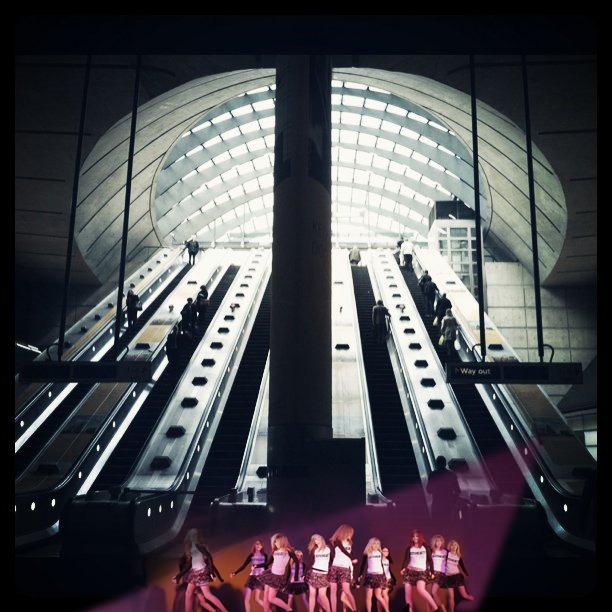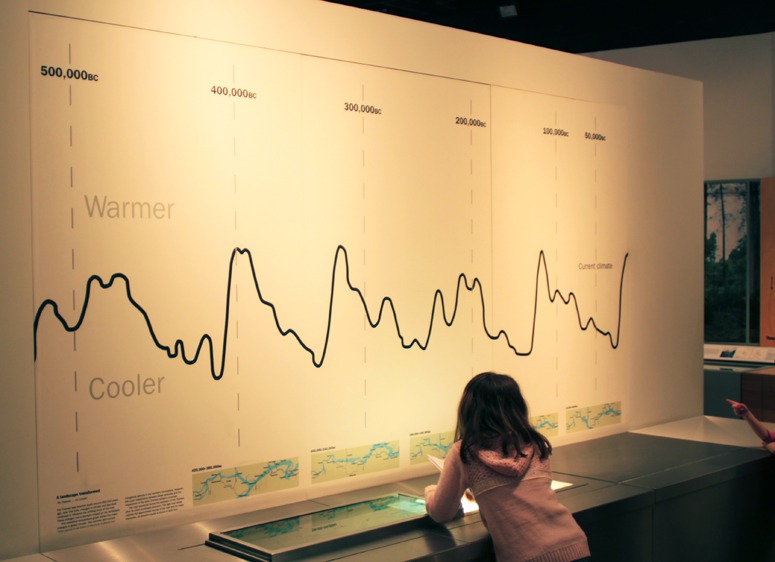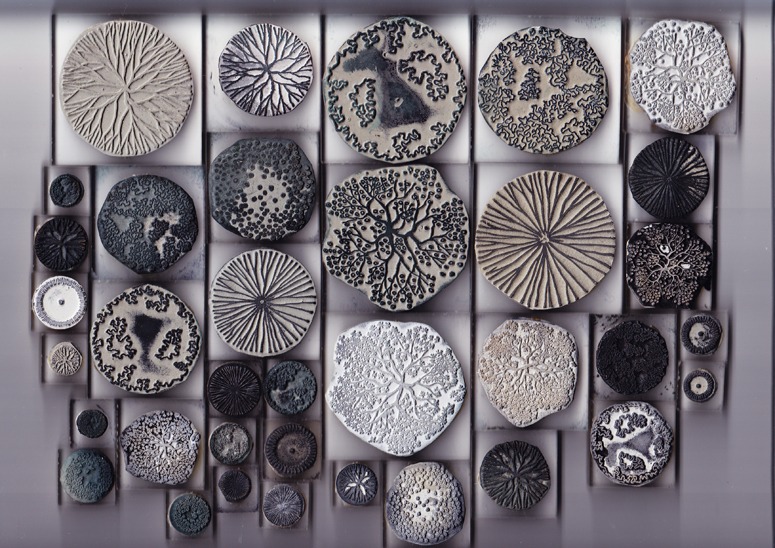The above chart, from the Museum of London, shows the pattern of climate change in the past 500,000 years. It does not have a vertical scale but I think mean temperatures were about ten degrees centigrade cooler at the Last Glacial Maximum (the last dip before the 50,000 years of global warming before the present). I am not a chart expert or a climate change expert but, to me, it looks as though a period of global cooling should be expected, whatever the consequences of man-made (anthropogenic) climate change.
Author Archives: Tom Turner
Lord Foster Airport Thames Hub Isle of Grain – landscape implications

George Orwell called it Airstrip One. It was in what “had been called England or Britain”. This was the homeland of Winston Smith, in his novel 1984. Not to be outdone, Lord Foster has set about designing Airstrip One, with help from Halcrows, as engineers, and Volterra, as economic consultants. Their report makes some good points: IF air traffic is to continue growing THEN London will need a new airport and IF London is to have a new airport THEN the Thames Estuary is the best location. Furthermore, one could hardly do better than Lord Foster as the designer. But he should have worked with a good landscape architect and I would recommend James Corner for the job. His firm’s name is ‘Field Operations’ and this is what the airport needs. The Foster design looks like an aircraft carrier moored in the Estuary. It will face the bitterest opposition from the people of Kent. The would-be developers would have a better chance with Boris Johnson’s Island Airport location. Could anything be done to improve the landscape acceptability of the Isle of Grain site? One thing is for sure: they could have done a very much better job with the water margin. It should be beautiful and ecological – providing a very special habitat for birds which do not have the habit of bringing down aircraft. Norman Foster has worked with some good landscape architects in his time but in essence he is an object-oriented designer, not a space-oriented designer. On this occasion, I think he has spent a lot of money and diminished the chances of an airport being built in the Thames Estuary. The protestors may come to think him for this and I remind him of the old proverb:
For want of a nail the shoe was lost.
For want of a shoe the horse was lost.
For want of a horse the rider was lost.
For want of a rider the message was lost.
For want of a message the battle was lost.
For want of a battle the kingdom was lost.
And all for the want of a horseshoe nail.
Bosco Verticale – vertical forest garden balconies in Milan
But will it work? I do not anticipate a horticultural problem with growing the trees. But will the residents want them? I am sceptical. A planted balcony with shrubs, flowers and living space is a delight. But there is a long history of residents not wanting large trees too near the windows of their houses. Trees keep out the sun and block views. The trees on top of the building should be a great success – providing the structural, horticultural and stability issues have been properly addressed.
Landscape architecture tree stamps
On my first day in a landscape architecture office the kind lady at the drawing board behind mine asked ‘What have you done before?’. I told her, modestly, ‘degrees in philosophy and landscape architecture’. ‘Ah’, she said, wisely and with a soft Scots accent,’an apprenticeship in the post office would more use – the main thing we do here is tree stamping’. So, in memory of that happy day, I give you a scan of a very high-class set of tree stamps, which belonged to my former colleague Michael Lancaster. A very good designer and draughtsman, I can’t think what he used them for. The largest stamps were unused until I had a go with them recently. Just think how much use they could be for retrospective planning in Chinese cities!
iGardens, iCities, iArchitecture, iLandscapes, iPads and the Steve Jobs design theory
Steve Jobs is the most successful product designer of modern times, bar none. Nobody has built so many fabled products. Nor have they built (what was briefly) the world’s largest coroporation in such a short working life – or such powerful brand loyalty. So if cities, gardens, architectures and landscapes are ‘products’ then what can designers learn from the Steve Jobs approach to design? Here are some of the possibilities:
- classify every design idea as ‘insanely great’ or ‘absolute shit’
- listen to ideas from members of the design team and tell the proposers they are all ‘absolute shit’,
- come in next day claiming the best of their ideas are yours, now seeing them as ‘insanely great’
- earn the undying love of your staff by these means
- ignore public consultation, and market research of all kinds, because ‘people do not know what they want until I have built it for them’
- practice Buddhism, become a vegan and drink bucket-loads of carrot juice
- adopt the purest forms of the Bauhaus and Zen Buddhist approaches to design
- focus, like a laser beam, on the user experience
- find the necessary technology to realise your dreams
- keep on and on and on simplifying and perfecting every detail of your design
- ‘Don’t compromise’
- ‘People who know what they’re talking about don’t need PowerPoint’
Yes, I have been reading Walter Isaacson’s biography of Steve Jobs and, yes, I think all designers can learn from Jobs’ example. But there is a big problem: I detest the idea of an iCity, an iGarden, an iScraper and an iLandscape – with the ‘i’ standing for ‘international’. I believe, fervently, that the environmental design professions should hold to the principles of context-sensitive design. They should, like our predecessors down the millennia, CONSULT THE GENIUS OF THE PLACE.
Steve was interested in gardens. The ‘stalk and head’ idea for the iMac G4 came from the sunflowers in his wife’s garden and, more to the point, he stated that ‘The most sublime thing I’ve ever seen are the gardens around Kyoto. I’m deeply moved by what that culture has produced, and it’s directly from zen Buddhism’. Since the Zen idea (禪) came from China and, before that, from India, perhaps Steve was not as strong on history as on product design.
“But there is one more thing that we want to tell you about…” East Asia is building iCities as if there is no tomorrow. So? “….Tomorrow will never come“.
See also 2012 Chelsea Fringe Flowers Gardens and Gardening Festival.
Buddha image courtesy Miheco.
Laser hologram projection of dancing girls at Canary Wharf Underground station
 London Transport need not worry about these girls obstructing the flow of communters from their suburban pads to the Canary Wharf money factory. They are a holographic projection into a thin cloud of disco fog, intended to give the salarymen and salarygirls a reminder of their next escape to Ibiza. [Nor do London Transport need to sue me for not having had a license to take the photograph: it is a simulation.] The troupe have decided to call themselfes the Flowers of Canary Wharf and are planning a performance for the 2012 Chelsea Fringe Garden Festival.
London Transport need not worry about these girls obstructing the flow of communters from their suburban pads to the Canary Wharf money factory. They are a holographic projection into a thin cloud of disco fog, intended to give the salarymen and salarygirls a reminder of their next escape to Ibiza. [Nor do London Transport need to sue me for not having had a license to take the photograph: it is a simulation.] The troupe have decided to call themselfes the Flowers of Canary Wharf and are planning a performance for the 2012 Chelsea Fringe Garden Festival.





